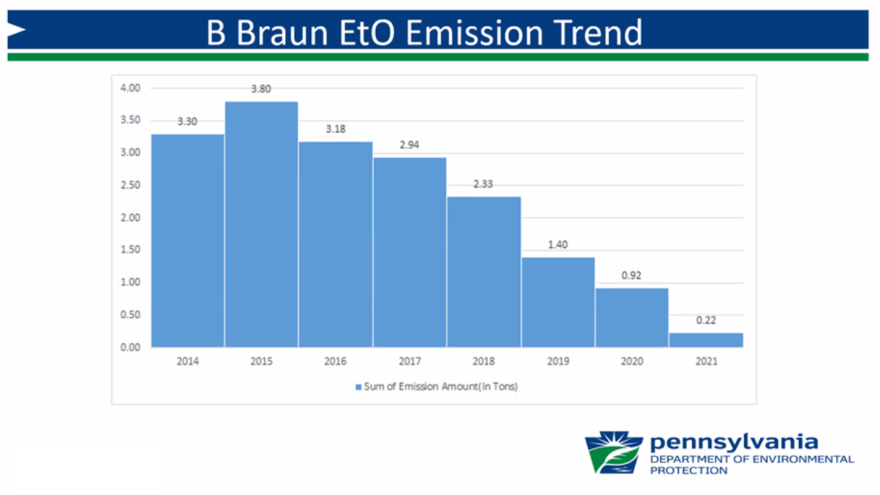ALLENTOWN, Pa. — The B. Braun plant in Hanover Township, Lehigh County, has significantly cut the cancer risk from ethylene oxide emissions, but there still is a potential risk from the facility, the federal Environmental Protection Agency told an online gathering Thursday.
New equipment installed voluntarily in 2019 and 2020 by the facility at 901 Marcon Blvd. has meant a lower risk than what predictions had laid out, EPA and state environmental and health officials said at the community meeting to highlight the risks associated with ethylene oxide and the steps B. Braun has taken to mitigate it.
- A virtual community meeting held by the U.S. Environmental Protection Agency (EPA) highlighted mitigation efforts and continuing concerns for long-term exposure to the carcinogenic chemical ethylene oxide, or EtO
- The event highlighted significant voluntary EtO emission reductions from the B. Braun commercial sterilizer in Hanover Township, which has faced lawsuits related to alleged cancer risk
- The EPA is set to propose new federal regulations for the chemical in the coming weeks
The B. Braun facilities use ethylene oxide to sterilize medical equipment and materials of bacteria and viruses. Ethylene oxide, or EtO, has been known to cause breast cancer and types of blood cancer.
Participants at the event discussed how, while the Allentown area was not among the 23 communities listed by the EPA that were of highest risk—with a rate of more than 100 per million individual risk for cancer based on information collected from the facilities—the current operations at B. Braun are contributing to continued risk from emissions of the chemical.
Officials say while previous equipment was designed to control 99% of EtO emissions, the new system, is designed to achieve 99.9% control. In practice, that resulted in a destruction of 99.98% of EtO and a significant reduction in overall EtO emissions. Speakers said the new control system has resulted in a 90% reduction in EtO emissions from 2018 to 2021.
The EPA says that EtO does not pose a risk from standard consumer use of a product sterilized with the chemical.
While Thursday's conversation focused on the likely impacts of those who live near sterilizers, the EPA noted there also is potential risk to those who work at the facilities or those who work or go to school nearby.
"While we do believe that B. Braun is no longer in the highest risk category, that doesn't necessarily mean that there was not risk in the past," Madeline Beal, senior risk communications specialist at the EPA, said.
"Our risk estimates here represent the current and future looking conditions and not historical conditions, because that's the best — and in some cases, that's the only — information we have. But it's also the information that we need to have in order to set the rules going forward to reduce risk and be more protective of health.
"Whether or not they're on the list of 23 that have the blue dots here, we're considering all 100 when we think about these issues, and proposed solutions and our regulations."
An initial nationwide analysis in 2018 found that EtO may be causing greater risk of cancer near sterilization facilities. The organization collected and analyzed data over the past two years to greater understand where risk is most present and what its source is.
The state Health Department in May published a data review this year of cancer incidence data within two miles of the B. Braun facility. It found that cancer rates observed were not consistent with patterns associated with environmental exposure, but also states that without real-time air monitoring data, the levels of EtO inhaled cannot be determined in a way sufficient for proper evaluation.
The EPA said that in July, the organization completed an analysis showing where risk is highest for communities nearby.
A full inspection by the state Department of Environmental Protection in November found no issues with the facility in complying with existing laws.
The organization said there has been no evidence that exposure to EtO near any of the facilities using the chemical is causing urgent or acute health issues like nausea or breathing problems. Rather, risk only shows in the presence of long-term exposure.
There are about 100 commercial sterilizer facilities in the United States, some utilizing EtO at a dangerous level. The EPA said that children and babies may be at higher risk than most adults.
A federal air toxin mapping created by the EPA based on 2018 emission data lists the area where these concerns are being raised as having a higher cancer risk than other areas in the Lehigh Valley.
B. Braun is the subject of lawsuits in recent years over concerns that it has contributed to residents' cancer diagnoses. Officials at the meeting said they could not comment on the lawsuits and B. Braun has made statements in the past claiming the lawsuits have no merit.
Lehigh Valley Planning Commission has also listed air quality as one of its concerns in the FutureLV Regional Plan.
The German medical and pharmaceutical device company has multiple locations throughout the Lehigh Valley and recently expanded its Hanover Township location.
At the event celebrating the expansion, Tony Iannelli, president of the Greater Lehigh Valley Chamber of Commerce, spoke in favor of B. Braun, alluding to the ongoing legal situation.
“This is my company in the broad sense as president of the chamber, and I don’t like when, in my mind, people try to draw or develop a negative premise," Iannelli said at the September event. “Their track record is unbelievable, and you have been so good to the Valley, not only in the amount of jobs that you’ve created, but the amount of people you’ve kept healthy and kept safe.”

"B. Braun has been a member of the Lehigh Valley community for over 40 years, dedicated to manufacturing life-saving products for people across the country and here in the Valley," B. Braun company spokeswoman Alli Logenhagen said.
"We appreciate that our EtO compliance track record and proactive efforts to reduce emissions were recognized by the federal and state regulatory officials at tonight’s EPA community meeting.
"B. Braun has always maintained the highest-level of safety and will continue its focus on keeping patients, its employees, and the community safe."
The meeting left a lot of time at the end for attendees to submit questions to be answered by the officials and experts, and the recording will be published online in the coming days.
The EPA said it plans this year to change regulations for the use of the chemical to better address and reduce air pollution from commercial sterilizers and that it was using these events to hear from the communities impacted by the chemical. There will also be a 60 day public comment period following when the new regulations are proposed.
"You deserve to be part of this process, to have your voices heard, your concerns shared and your needs met," Christina Fernandez, air protection division director for the Mid-Atlantic EPA, said.
Those with further questions regarding EtO pollution and exposure are encouraged to contact eto@epa.gov
Community updates regarding the B Braun facility near Allentown are available at epa.gov/eto/allentown.


